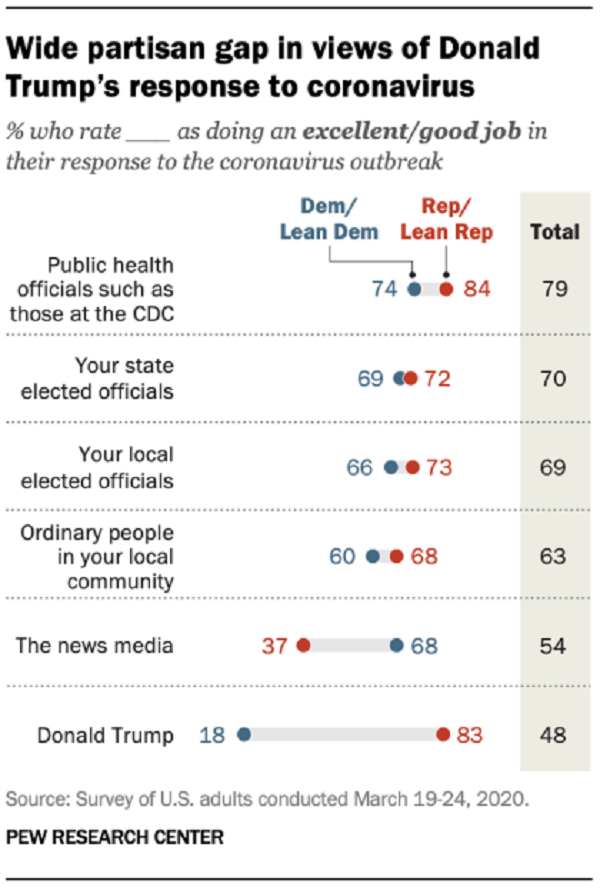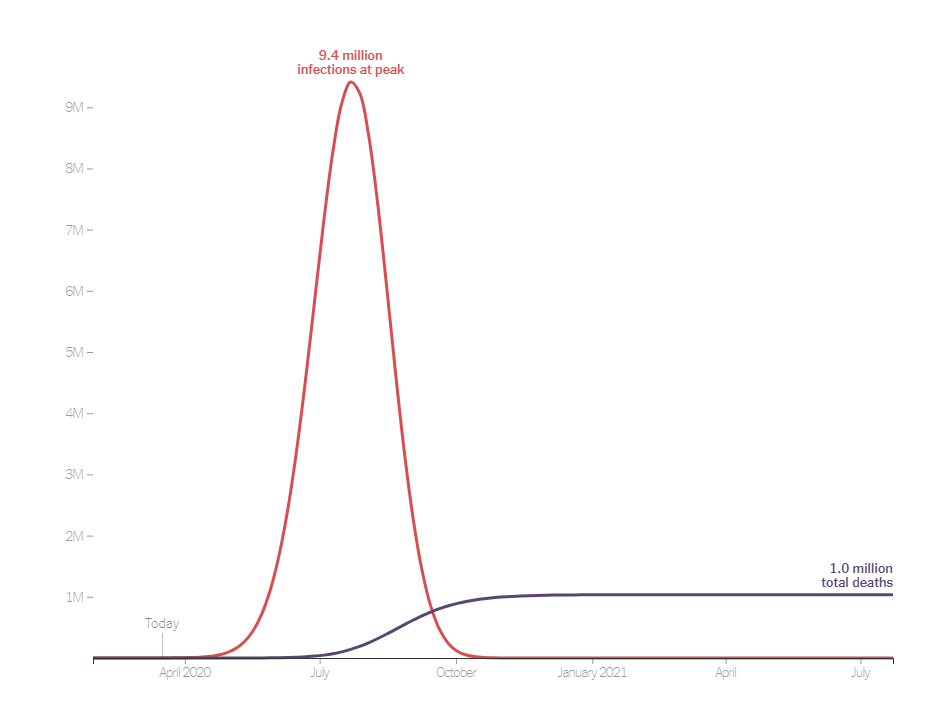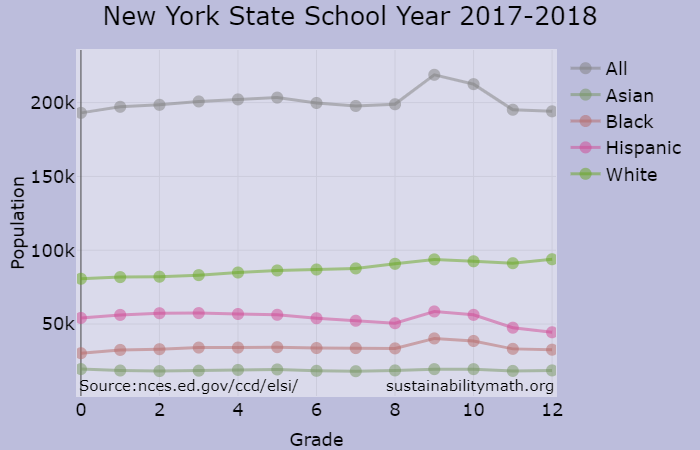Who has the highest Gini of G7 countries?
 The Pew article 6 facts about economic inequality in the U.S. by Katherine Schaeffer (2/7/2020) provides the chart copied here (2017 data). One of the other facts mentioned in the article:
The Pew article 6 facts about economic inequality in the U.S. by Katherine Schaeffer (2/7/2020) provides the chart copied here (2017 data). One of the other facts mentioned in the article:
In 1989, the richest 5% of families had 114 times as much wealth as families in the second quintile (one tier above the lowest), at the median $2.3 million compared with $20,300. By 2016, the top 5% held 248 times as much wealth at the median. (The median wealth of the poorest 20% is either zero or negative in most years we examined.)
There are 6 (surprise) charts and the data is cited. Great QL article.
What are people’s view of C-19?
 The Pew article Worries About Coronavirus Surge, as Most Americans Expect a Recession – or Worse (3/26/2020) reports the results from a survey related to COVID-19. Most of it is not too surprising:
The Pew article Worries About Coronavirus Surge, as Most Americans Expect a Recession – or Worse (3/26/2020) reports the results from a survey related to COVID-19. Most of it is not too surprising:
There is broad public agreement that the nation is confronting a crisis. Two-thirds of Americans – including majorities in all major demographic and partisan groups – say COVID-19 is a “significant crisis.”
But, then there is the graphic copied here. Ok, the partisan split on the news media and the President aren’t that surprising, while still quit stark. Interestingly, Dem/Lean Dem rank the top four categories consistently lower than Rep/Lean Rep. The CDC gets 10 percentage points lower and ordinary people 8 percentage points lower.
There are numerous charts of survey responses and the article has a methodology section with data.
C-19, counts or per capita?
 The media tends to focus on the number C-19 deaths in a country, but per capita provides a better understanding of the impact in a country. The Our World in Data page Coronavirus Disease (COVID-19) – Statistics and Research page has interactive graphs for per capita deaths. For example, currently Italy is over 7,500 deaths, but I didn’t put Italy on the chart because they are at 113 deaths per million and that made it hard to see the other countries I selected. In fact, Spain is at 3,650 deaths and 58 deaths per million was also left off.
The media tends to focus on the number C-19 deaths in a country, but per capita provides a better understanding of the impact in a country. The Our World in Data page Coronavirus Disease (COVID-19) – Statistics and Research page has interactive graphs for per capita deaths. For example, currently Italy is over 7,500 deaths, but I didn’t put Italy on the chart because they are at 113 deaths per million and that made it hard to see the other countries I selected. In fact, Spain is at 3,650 deaths and 58 deaths per million was also left off.
Italy, currently the worst case scenario, broke 1 death per million on March 4. The U.S. is nearly 3 weeks behind breaking 1 death per million on March 22. China, despite over 3,000 deaths has kept the per capita deaths to 2.25 per million. I’d also argue that deaths are more accurate confirmed cases, since confirmed cases depend on the testing regime.
The data is available for download on the Our World in Data page.
What does it mean to “flatten the curve”?
 The New York Times article How Much Worse the Coronavirus Could Get, in Charts by Nicholas Kristof and Stuart A. Thompson (3/13/2020) has a great interactive set of graphs that illustrate the importance of flattening the curve. The graphs start with the one copied here.
The New York Times article How Much Worse the Coronavirus Could Get, in Charts by Nicholas Kristof and Stuart A. Thompson (3/13/2020) has a great interactive set of graphs that illustrate the importance of flattening the curve. The graphs start with the one copied here.
What’s at stake in this coronavirus pandemic? How many Americans can become infected? How many might die?
The answers depend on the actions we take — and, crucially, on when we take them. Working with infectious disease epidemiologists, we developed this interactive tool that lets you see what may lie ahead in the United States and how much of a difference it could make if officials act quickly.
One of the interesting features is that the user can drag a bar which is the date interventions begin and see how the curve changes.
How is spring changing?
 Climate Central has put together their 2020 Spring Package (2/2/2020) with information and a selection of city graphs. For example
Climate Central has put together their 2020 Spring Package (2/2/2020) with information and a selection of city graphs. For example
Analyzing average spring temperatures since 1970, the top increases occurred in the Southwest—where spring is the fastest warming season. Reno, Nev. topped the list with an increase of 7.2°F, followed by Las Vegas, Nev. (6.4°F), El Paso, Texas (5.8°F), and Tucson (5.8°F). In general, 81% (197) of the 242 cities analyzed warmed by at least 1°F over the past fifty years.
There are four different graph selections for spring: Average Temperature, Days Above Normal, Last Freeze, and a National Map. For the first three you can select from various cities. For example, I chose the graph for last freeze for Duluth, MN, which shows that on average the last freeze is occurring almost two weeks sooner.
The graphs are set up for easy download but there isn’t corresponding data. A previous post How much have fall nighttime temperatures risen? provides details on how to obtain this type of data.
How have counties grown since the great recession?
 The Washington Center for Equitable Growth article New measure of county-level GDP gives insight into local-level U.S. economic growth by Raksha Kopparam (12/16/2019) provides the map copied here.
The Washington Center for Equitable Growth article New measure of county-level GDP gives insight into local-level U.S. economic growth by Raksha Kopparam (12/16/2019) provides the map copied here.
Making GDP a more useful metric may require peeling it apart and looking at the data more closely. On December 12, the U.S. Department of Commerce’s Bureau of Economic Analysis released a new measure of economic growth that does just this—Local Area Gross Domestic Product. LAGDP is an estimate of GDP at the county level between the years of 2001—2018. This measure allows policymakers and economists alike to examine local-level economic conditions and responses to economic shocks and recovery.
The new data measurement shows that private-sector industries across the nation have experienced growth since the end of the Great Recession in mid-2009, yet most of this growth is concentrated in the West Coast states and parts of the Midwest.
The article has three other maps two of which are growth based on the tech sectors and manufacturing. Each graph has a url citation for the data.
How did minimum wage increases impact wage growth?
 This graph from the EPI post Low-wage workers saw the biggest wage growth in sates that increased their minimum wage between 2018 and 2019 by Elise Gould (3/4/2020) answers part of the question. It is worth noting that:
This graph from the EPI post Low-wage workers saw the biggest wage growth in sates that increased their minimum wage between 2018 and 2019 by Elise Gould (3/4/2020) answers part of the question. It is worth noting that:
Strong wage growth at the 10th percentile is not simply due to stronger overall wage growth in those states.
Between 2018 and 2019, the median and 80th percentile wage in states with minimum wage changes increased 0.7% and 1.5%, respectively, while they increased 2.1% and 2.4%, respectively, in non-changing states.
There are three other graphs in the article and each has a link to data.
What’s New at sustainabilitymath?
 In a follow up to last week’s graph, I have added a demographic graph of New York State, which provides the number of students in each grade in the 2017-2018 school year by race. The hover information includes percentages for each group. The data comes from the National Center for Education Statistics Elementary/Secondary Information System (ELSi). The link will take you to various table generators and it is easy enough to get data for your state and even data at the district level is available.
In a follow up to last week’s graph, I have added a demographic graph of New York State, which provides the number of students in each grade in the 2017-2018 school year by race. The hover information includes percentages for each group. The data comes from the National Center for Education Statistics Elementary/Secondary Information System (ELSi). The link will take you to various table generators and it is easy enough to get data for your state and even data at the district level is available.
Isn’t the sun causing global warming?
 No, as can be easily seen by the graphic here copied from the NASA article There is No Impending ‘Mini Ice Age’ (2/13/2020). At the same time we won’t be seeing an ice age anytime soon:
No, as can be easily seen by the graphic here copied from the NASA article There is No Impending ‘Mini Ice Age’ (2/13/2020). At the same time we won’t be seeing an ice age anytime soon:
This is called a “Grand Solar Minimum,” and the last time this happened, it coincided with a period called the “Little Ice Age” (a period of extremely low solar activity from approximately AD 1650 to 1715 in the Northern Hemisphere, when a combination of cooling from volcanic aerosols and low solar activity produced lower surface temperatures).
Even if a Grand Solar Minimum were to last a century, global temperatures would continue to warm. Because more factors than just variations in the Sun’s output change global temperatures on Earth, the most dominant of those today being the warming coming from human-induced greenhouse gas emissions.
The article has another time series of solar irradiance with a source.